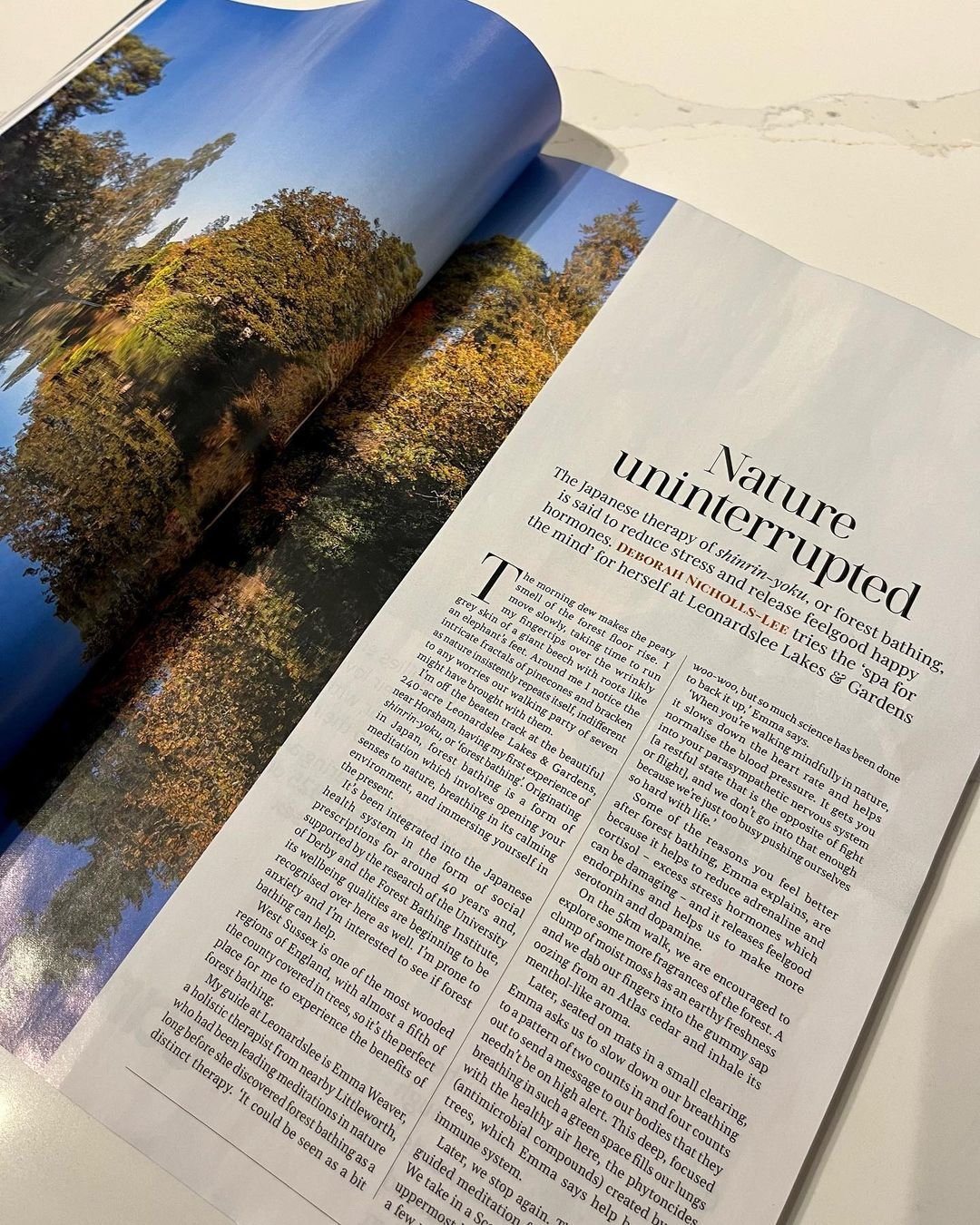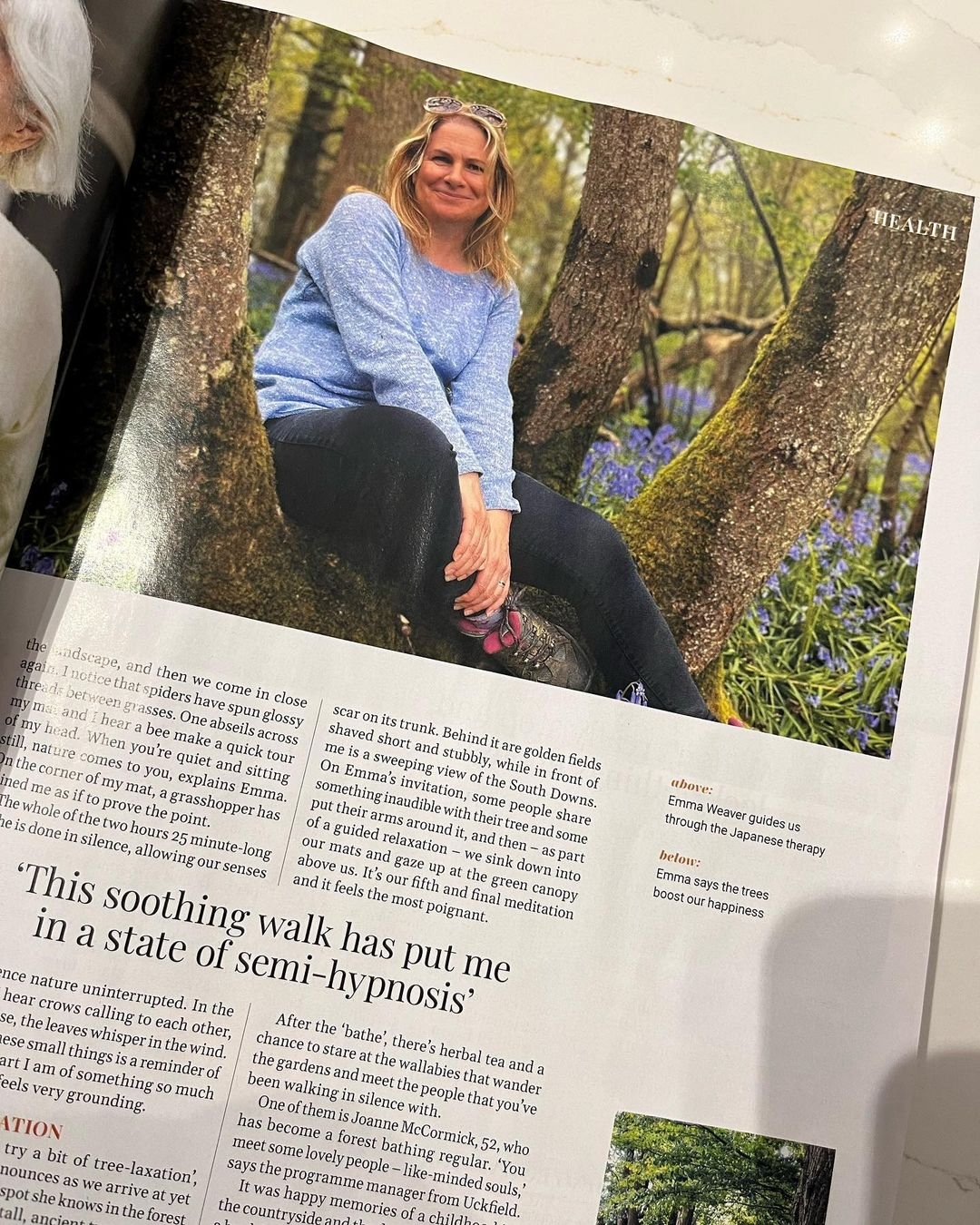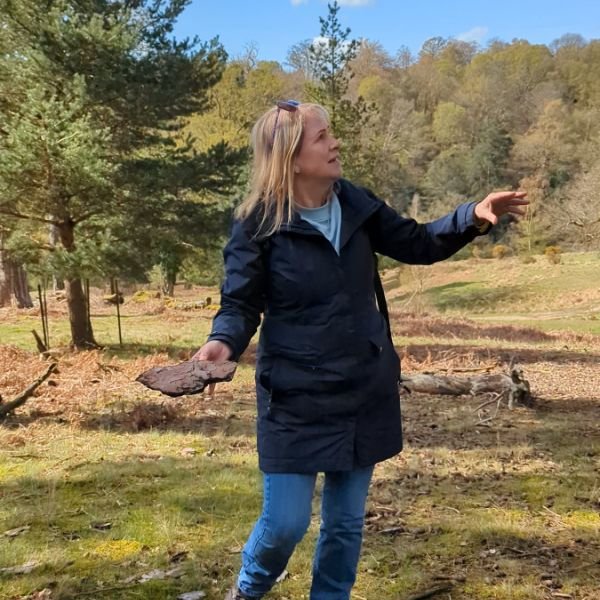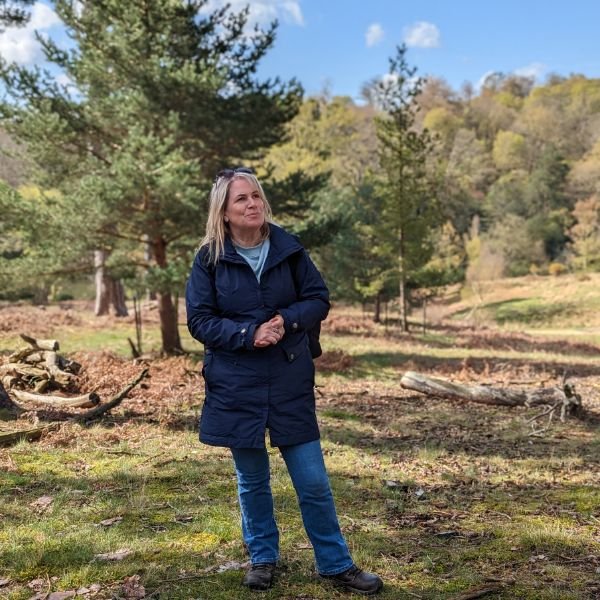Forest bathing beneath Sussex’s green canopy
Written By: Deborah Nicholls-Lee from Sussex Life Magazine
The morning dew makes the peaty smell of the forest floor rise up.
The morning dew makes the peaty smell of the forest floor rise up. I move slowly, taking time to run my hands over the wrinkly grey skin of a giant beech with elephantine feet. I notice the intricate fractals of pine cones and bracken as nature insistently repeats itself, indifferent to any worries our walking party of seven might have brought with them.
I’m off the beaten track at the beautiful 240-acre Leonardslee Lakes & Gardens, near Horsham, having my first experience of shinrin-yoku, or ‘forest bathing’. Originating in Japan, forest bathing is a form of meditation which involves opening your senses to nature, breathing in its calming environment and immersing yourself in the present. I’m prone to anxiety and I’m interested to see if forest bathing can help. It’s been integrated into the Japanese health system in the form of social prescriptions for around 40 years and, supported by the research of the University of Derby and the Forest Bathing Institute, its wellbeing qualities are beginning to be recognised over here as well.
Emma Weaver
West Sussex is one of the most wooded regions of England, with almost a fifth of the county covered in trees, so it’s the perfect place for me to experience the benefits of forest bathing. My guide at Leonardslee is Emma Weaver, a holistic therapist from nearby Littleworth who had been leading meditations in nature long before she discovered forest bathing as a distinct therapy.
‘It could be seen as a bit woo-woo, but so much science has been done to back it up,’ says Emma. ‘When you’re walking mindfully and slowly in nature, it slows down the heart rate and helps normalise the blood pressure. It gets you into your parasympathetic nervous system [a restful state that is the opposite of fight or flight], and we don’t go into that enough because we’re just too busy pushing ourselves so hard with life.’
Some of the reasons you feel better after forest bathing, Emma explains, are because it helps to reduce adrenaline and cortisol − excess stress hormones which can be damaging − and it releases feel-good endorphins and helps us to make more serotonin and dopamine.
Back on the walk, we are encouraged to explore some more fragrances of the forest. A clump of moist moss has an earthy freshness and we dab our fingers into the gummy sap oozing from an Atlas cedar and inhale its menthol-like aroma. Later, seated on mats in a small clearing, Emma asks us to slow down our breathing to a pattern of two counts in, and four counts out to send a message to our bodies that they needn’t be on high alert. This deep, focused breathing in such a green space fills our lungs with the healthy air here, the phytoncides created by the trees, which Emma says help boost the immune system.
Later, we stop again. This time, Emma’s guided meditation focuses on our vision. We take in a Scots pine from its roots to its uppermost boughs, we draw back and, for a few minutes, take a wide-angled view of the landscape, and then we come in close again. I notice that spiders have spun glossy threads between grasses.
One abseils across my mat and I hear a bee make a quick tour of my head. When you’re quiet and sitting still, nature comes to you, explains Emma. On the corner of my mat, a grasshopper has joined me as if to prove the point.
The whole of the bathe is done in silence, allowing our senses to experience nature uninterrupted. In the distance, I hear crows calling to each other, while up close, the leaves whisper in the wind. Observing these small things is a reminder of what a tiny part I am of something so much bigger and it feels very grounding.
‘We’re going to try a bit of tree-laxation’, Emma gently announces as we arrive at yet another stunning spot she knows in the forest with a pageant of tall, ancient trees. We are invited to choose the tree we are most drawn to and get to know it better. Normally, I might tense up at an activity like this, but this soothing walk has put me in a state of semi-hypnosis and I’m open to the new experience.
My tree is a beech dressed in green velvet stockings of fine moss with an eye-shaped scar on its trunk. Behind it are golden fields shaved short and stubbly, while in front of me is a sweeping view of the South Downs. On Emma’s invitation, some people share something inaudible with their tree and some put their arms around it, and then – as part of a guided relaxation – we sink down into our mats and gaze up at the green canopy above us. It’s our fifth and final meditation and it feels the most poignant.
After the ‘bathe’, there’s herbal tea and a chance to meet the people that you’ve been walking in silence with. One of them is Joanne McCormick (52), who has become a regular. ‘You meet some lovely people – like-minded souls,’ says the Programme Manager from Uckfield, who has stayed in touch with several of her fellow forest bathers.
It was happy memories of a childhood in the countryside and the discovery, in 2018, of a book by Dr Qing Li, the leading researcher in this field, that sparked Joanne’s interest in forest bathing. ‘If I start to feel more anxious or stressed, then the minute I step outside, that dissipates,’ she says, describing forest bathing as ‘a spa for the mind’.
Doing forest bathing through the different seasons reminds you that nothing’s permanent, she says. ‘Whatever’s happening, nature just continues. There’s a rhythm to it and a flow to it that’s just lovely … You’ll see a really old tree that’s been battered by the storms and shaped by its environment and I think it just helps me to put things into perspective a little bit and realise that you’re here for such a short amount of time and there’s trees that have stood for hundreds of years.’
Joanne also finds that it helps her with her work. ‘[Afterwards,] I feel more creative. I think if you give yourself that space in your head, it allows room for other things to come in.’
I notice that too, but first, within hours of the session, I do something I can’t remember doing before: I fall asleep in the garden. Keen forest bather, Paula Daly (61), a charity worker from Horsham, reports a similar effect. ‘In the week after I’ve done a session, I sleep much better than I do normally,’ she tells me. ‘It’s like having a weighted blanket on your nerves and it’s just really lovely.’
When Paula tells people she’s going forest bathing, she is usually met with ‘a look of puzzlement’, she says, or people confuse it with wild swimming. Paula loves being guided by Emma, who she says has ‘a lovely soft voice’ and ‘is really interesting to listen to and knows her subject so well’. And Leonardslee is ‘a very pretty place to do it’, she says. Paula has since become a member there and she has noticed that, since she began forest bathing, she is choosing to spend less time in towns and more time in nature.
Forest bathing appeals to her on multiple levels: ‘I like the exercise element and I like the fact that you literally leave everything behind, turn the phone off, and you’re going into a space where there’s no outside world and you can just let it all go for a bit.’ ‘It’s very sensory and mindful,’ she adds. ‘We all lead quite busy lives and we don’t really stop and look at things enough and making time to do that is really important, I think.’
As for me, the benefits are palpable. It’s cleared my mind, relaxed my body and renewed some of that childlike wonder that the demands of grown-up life had eroded. And the great thing about forest bathing is you need so little: just a good knowledge of a patch of nature, walking boots, water, a mat, and long sleeves and trousers to deter ticks and protect you from brambles and nettles. ‘It’s just so simple,’ says Emma, who loves seeing the transformation in people. As for the science behind it, you can take it or leave it. ‘You’ve only got to try it to know that it works,’ she says.
Emma Weaver (emmaweavertherapies.co.uk) runs regular forest bathing sessions at Leonardslee Lakes & Gardens in Lower Beeding (leonardsleegardens.co.uk) and in Rockinghill Wood at Standen House and Garden, near East Grinstead (nationaltrust.org.uk/visit/sussex/standen-house-and-garden).
BOX OUT
Forest bathing has taken root across Sussex. Here are more locations offering immersive experiences among the trees:
The Spread Eagle in Midhurst and Wakehurst Kew Gardens in Ardingly host sessions run by Helena Skoog (forestbathingsussex.co.uk), whose experience of living off-grid in Sussex woodland feeds into her popular sessions.
Amanda Bate (amandala.uk) walks forest bathers through the grounds of Farleys House & Gallery in Chiddingly, home of the surrealists, and the National Trust’s Sheffield Park and Gardens in Uckfield. She also runs yoga and forest bathing sessions in Brighton’s Stanmer Park.
Offering forest bathing in ancient woodlands in Arundel and a beach version of the concept in Littlehampton, nature therapist Holly Barber’s calming, meditative walks invite an exploration of some of Sussex’s most beautiful landscapes. (the-eco-monkey.com)









